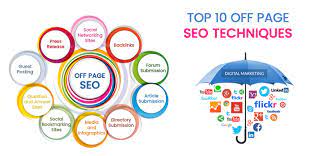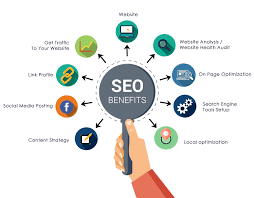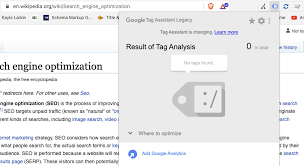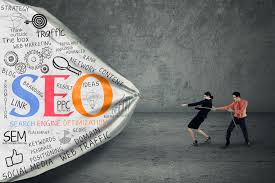Mastering On-Page Optimization: A Key to Digital Marketing Success
On-Page Optimization: Boosting Your Digital Marketing Strategy
In the vast realm of digital marketing, on-page optimization plays a pivotal role in enhancing your online presence and driving organic traffic to your website. It involves optimizing various elements on your web pages to improve search engine rankings and provide a seamless user experience. Let’s delve into the significance of on-page optimization and explore some key strategies to implement.
First and foremost, on-page optimization revolves around optimizing your website’s content. This includes conducting thorough keyword research to identify relevant terms and phrases that your target audience is searching for. By strategically incorporating these keywords into your page titles, headings, meta descriptions, and throughout the content itself, search engines can better understand the context of your web pages.
Meta tags are another crucial aspect of on-page optimization. Meta titles and meta descriptions provide concise summaries of what each page is about. Crafting compelling meta tags that include relevant keywords can significantly impact click-through rates from search engine results pages (SERPs), enticing users to visit your website.
Optimizing URLs is often overlooked but can have a significant impact on search engine rankings. Creating clean, descriptive URLs that include relevant keywords helps both search engines and users understand what the page is about before even clicking on it.
Additionally, optimizing images is essential for both SEO purposes and user experience. Compressing images to reduce file size improves page loading speed, which is a crucial ranking factor in search engine algorithms. Adding alt text to images not only helps visually impaired users understand the content but also provides an opportunity to include relevant keywords for SEO benefits.
User experience should always be at the forefront of any digital marketing strategy. Ensuring fast page loading times, easy navigation, and mobile responsiveness are all critical factors in providing a positive user experience. Search engines prioritize websites that offer a seamless browsing experience across different devices.
Furthermore, internal linking within your website helps search engines navigate through your content more efficiently while also providing users with additional relevant information. Linking related pages together helps establish a logical website structure and improves user engagement.
Regularly monitoring and analyzing your on-page optimization efforts is crucial to measure success and identify areas for improvement. Utilizing various analytical tools can provide valuable insights into user behavior, traffic sources, and keyword performance. These insights can help you refine your on-page optimization strategy over time.
In conclusion, on-page optimization is a fundamental aspect of any successful digital marketing strategy. By optimizing your website’s content, meta tags, URLs, images, and user experience, you can improve search engine rankings, attract more organic traffic, and ultimately achieve your online marketing goals. Embrace the power of on-page optimization and unlock the full potential of your digital presence.
5 Commonly Asked Questions About On-Page Optimization in Digital Marketing
- What is on page optimization in digital marketing?
- How does on page optimization improve SEO?
- What are the key elements of on page optimization?
- How do I optimize my website for better rankings?
- What techniques should I use for effective on page optimization?
What is on page optimization in digital marketing?
On-page optimization in digital marketing refers to the practice of optimizing various elements on a website to improve its visibility and ranking in search engine results pages (SERPs). It involves optimizing factors directly within the website itself, focusing on content, meta tags, URLs, images, user experience, and other on-page elements.
The goal of on-page optimization is to make a website more search engine-friendly and user-friendly, ensuring that search engines can understand the website’s content and users can easily navigate and engage with it. By implementing effective on-page optimization strategies, businesses can increase their organic search visibility, attract relevant traffic, and ultimately drive conversions.
Key components of on-page optimization include:
- Keyword Research: Identifying relevant keywords and phrases that users are searching for in relation to your business or industry.
- Content Optimization: Creating high-quality, informative, and engaging content that incorporates targeted keywords strategically throughout headings, paragraphs, and other relevant areas.
- Meta Tags Optimization: Optimizing meta titles and meta descriptions with compelling copy that accurately represents the page’s content while incorporating relevant keywords.
- URL Structure: Creating clean and descriptive URLs that include targeted keywords to provide both search engines and users with a clear understanding of the page’s topic.
- Image Optimization: Optimizing images by compressing them for faster loading times while adding descriptive alt text that includes relevant keywords for SEO benefits.
- User Experience (UX): Ensuring a positive browsing experience by improving page loading speed, mobile responsiveness, easy navigation, logical site structure, and engaging internal linking.
- Technical SEO: Implementing technical optimizations such as XML sitemaps, canonical tags, schema markup, robots.txt files to assist search engines in crawling and indexing your website effectively.
- Analytics & Monitoring: Regularly tracking performance metrics using analytical tools to measure the effectiveness of on-page optimization efforts and identify areas for improvement.
By paying attention to these on-page factors and continuously optimizing them, businesses can enhance their website’s visibility, attract more targeted organic traffic, and improve overall user engagement. On-page optimization is an essential component of a comprehensive digital marketing strategy aimed at improving search engine rankings and driving online success.
How does on page optimization improve SEO?
On-page optimization plays a crucial role in improving SEO (Search Engine Optimization) by optimizing various elements on your web pages to make them more search engine-friendly. Here are some ways in which on-page optimization improves SEO:
- Keyword Relevance: By conducting thorough keyword research and strategically incorporating relevant keywords into your page titles, headings, meta descriptions, and content, you increase the chances of search engines understanding the relevance of your web pages to specific search queries. This helps improve your rankings for those keywords.
- Enhanced User Experience: On-page optimization focuses on improving user experience by ensuring fast page loading times, easy navigation, mobile responsiveness, and well-structured content. Search engines prioritize websites that provide a positive user experience, leading to higher rankings.
- Improved Click-Through Rates: Crafting compelling meta titles and descriptions that include relevant keywords can significantly impact click-through rates from search engine results pages (SERPs). When users see enticing and informative snippets in the SERPs, they are more likely to click on your website.
- Better Indexing: Optimizing URLs with descriptive text helps search engines understand the context of your web pages before even visiting them. Clear and concise URLs that include relevant keywords make it easier for search engine crawlers to index and rank your pages accurately.
- Image Optimization: Optimizing images by compressing their file size improves page loading speed, which is a crucial ranking factor. Additionally, adding alt text to images helps search engines understand their content while also providing an opportunity to include relevant keywords for better SEO.
- Internal Linking: By strategically linking related pages within your website, you establish a logical website structure that aids search engine crawlers in navigating through your content more effectively. Internal linking also improves user engagement by providing additional relevant information.
- Continuous Improvement: Regularly monitoring and analyzing on-page optimization efforts using analytical tools provides insights into user behavior, traffic sources, keyword performance, and other valuable data. This allows you to refine and improve your on-page optimization strategy over time, leading to better SEO results.
In summary, on-page optimization improves SEO by making your web pages more relevant, user-friendly, and easily understandable by search engines. It helps increase keyword relevance, enhance user experience, improve click-through rates, facilitate better indexing, optimize images, implement internal linking, and enables continuous improvement of your SEO efforts.
What are the key elements of on page optimization?
The key elements of on-page optimization include:
- Keyword Research: Conducting thorough keyword research to identify relevant terms and phrases that your target audience is searching for.
- Page Titles: Creating unique, descriptive, and keyword-rich titles for each web page.
- Meta Descriptions: Crafting concise summaries of the page’s content that entice users to click through from SERPs.
- URL Structure: Creating clean, readable URLs that include relevant keywords and accurately describe the page’s content.
- Heading Tags: Utilizing heading tags (H1, H2, etc.) to structure your content and highlight important sections.
- Content Optimization: Strategically incorporating keywords throughout the content while maintaining a natural flow and readability.
- Image Optimization: Compressing images to reduce file size for faster loading times and adding alt text with relevant keywords for SEO benefits.
- Internal Linking: Linking related pages within your website to establish a logical site structure and improve user navigation.
- User Experience (UX): Ensuring fast page loading times, easy navigation, mobile responsiveness, and a visually appealing design.
- Schema Markup: Implementing structured data markup to provide search engines with additional context about your content.
- Social Sharing Integration: Adding social sharing buttons to encourage users to share your content across various platforms.
- Analytics and Monitoring: Regularly monitoring and analyzing on-page optimization efforts using tools like Google Analytics to measure success and make data-driven improvements.
Remember, on-page optimization is an ongoing process that requires continuous monitoring, analysis, and adaptation to stay ahead in the ever-changing digital landscape.
How do I optimize my website for better rankings?
Optimizing your website for better rankings involves implementing various on-page and off-page optimization techniques. Here are some key steps to help you improve your website’s visibility in search engine results:
- Keyword Research: Conduct thorough keyword research to identify relevant terms and phrases that your target audience is searching for. Use keyword research tools to find high-volume keywords with low competition.
- On-Page Optimization: Incorporate the identified keywords strategically throughout your website’s content, including page titles, headings, meta descriptions, and within the body text. Ensure that the content is informative, engaging, and provides value to users.
- Meta Tags: Craft compelling meta titles and meta descriptions for each page using relevant keywords. These tags provide concise summaries of your pages in search engine results and can significantly impact click-through rates.
- URL Structure: Create clean, descriptive URLs that include relevant keywords. Avoid long or complex URLs as they can be difficult for both users and search engines to understand.
- Image Optimization: Optimize images by compressing them to reduce file size without compromising quality. Add alt text to images using descriptive keywords to enhance SEO and provide accessibility for visually impaired users.
- Mobile Responsiveness: Ensure that your website is mobile-friendly and responsive across different devices. Mobile-friendliness is a crucial ranking factor in search engine algorithms due to the increasing number of mobile users.
- Page Loading Speed: Improve page loading times by optimizing code, compressing images, and utilizing caching techniques. Faster-loading pages enhance user experience and contribute to higher search engine rankings.
- Quality Content: Create high-quality, original content that provides value to users and addresses their needs or queries effectively. Regularly update your content with fresh information to keep it relevant and engaging.
- User Experience (UX): Focus on providing a seamless browsing experience by optimizing navigation menus, improving site structure, and ensuring easy accessibility across different devices.
- Link Building: Build high-quality backlinks from reputable websites within your industry. This can be achieved through guest blogging, influencer collaborations, and creating shareable content that naturally attracts links.
- Social Media Presence: Establish an active presence on relevant social media platforms to engage with your audience, promote your content, and drive traffic to your website.
- Analytics and Monitoring: Utilize web analytics tools to monitor and analyze website performance, user behavior, traffic sources, and keyword rankings. This data will help you identify areas for improvement and make data-driven decisions.
Remember that SEO is an ongoing process that requires consistent effort and adaptation to changes in search engine algorithms. By implementing these optimization techniques and staying up-to-date with industry best practices, you can improve your website’s rankings and attract more organic traffic over time.
What techniques should I use for effective on page optimization?
To ensure effective on-page optimization for your website, you can employ the following techniques:
- Conduct thorough keyword research: Identify relevant keywords and phrases that align with your target audience’s search intent. Use keyword research tools to find high-volume, low-competition keywords that you can strategically incorporate into your content.
- Optimize page titles: Craft compelling and concise page titles that accurately describe the content of each web page. Include relevant keywords towards the beginning of the title to improve search engine visibility.
- Write compelling meta descriptions: Create unique meta descriptions for each web page, summarizing its content and enticing users to click through from SERPs. Incorporate relevant keywords naturally while maintaining a clear and concise description.
- Utilize header tags (H1, H2, etc.): Structure your content using header tags to provide hierarchy and improve readability. Place target keywords in appropriate header tags to signal their importance to search engines.
- Optimize URL structure: Create clean and descriptive URLs that include relevant keywords whenever possible. Avoid using long strings of numbers or irrelevant characters in URLs as they can confuse both search engines and users.
- Optimize image attributes: Compress images to reduce file size without compromising quality, as faster loading times positively impact user experience and SEO rankings. Add descriptive alt text to images, including relevant keywords where appropriate.
- Improve website speed: Ensure fast page loading times by optimizing code, compressing files, leveraging browser caching, and utilizing content delivery networks (CDNs). Faster websites are preferred by both users and search engines.
- Enhance mobile responsiveness: With the increasing use of mobile devices for browsing, it’s crucial to optimize your website for mobile responsiveness. Ensure that your website adapts well to different screen sizes and provides a seamless user experience across devices.
- Implement internal linking: Link related pages within your website using descriptive anchor text to establish a logical website structure and help search engines understand the relationships between different pages. Internal linking also improves user navigation and engagement.
- Regularly update and optimize content: Keep your website’s content fresh, relevant, and valuable to visitors. Regularly update and optimize existing content based on user feedback, industry trends, and keyword performance.
Remember that effective on-page optimization is an ongoing process. Continuously monitor your website’s performance using analytical tools, adapt to changes in search engine algorithms, and refine your optimization techniques accordingly.








Leave a Comment